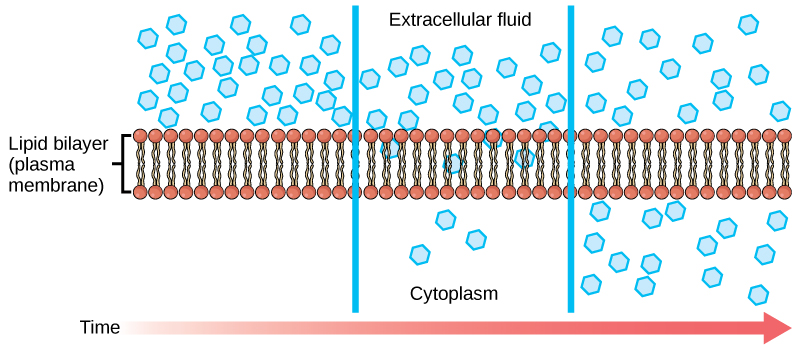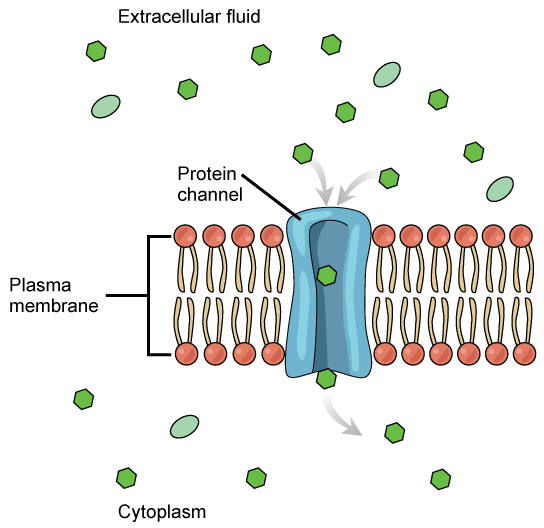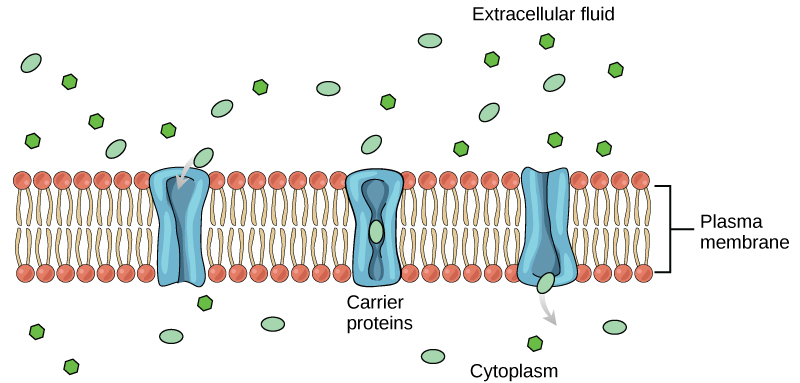10.1 Passive Transport
Plasma membranes must allow certain substances to enter and leave a cell, and prevent some harmful materials from entering and some essential materials from leaving. In other words, plasma membranes are selectively permeable—they allow some substances to pass through, but not others. If they were to lose this selectivity, the cell would no longer be able to sustain itself, and it would be destroyed.
Some cells require larger amounts of specific substances. They must have a way of obtaining these materials from extracellular fluids. This may happen passively, as certain materials move back and forth, or the cell may have special mechanisms that facilitate transport.
The most direct forms of membrane transport are passive. Passive transport is a naturally occurring phenomenon and does not require the cell to exert any of its energy to accomplish the movement. In passive transport, substances move from an area of higher concentration to an area of lower concentration. A concentration gradient can be defined as a physical space in which different regions of that space have a different concentration of a particular substance.
Selective Permeability
Recall that plasma membranes are amphiphilic: They have hydrophilic and hydrophobic regions. This characteristic helps move some materials through the membrane and hinders the movement of others. Non-polar and lipid-soluble substances with a low molecular weight can easily slip through the membrane’s hydrophobic lipid core. Substances such as the fat-soluble vitamins A, D, E, and K readily pass through the plasma membranes in the digestive tract and other tissues. Fat-soluble drugs and hormones also gain easy entry into cells and readily transport themselves into the body’s tissues and organs. Oxygen and carbon dioxide molecules have no charge and pass through membranes by simple diffusion.
Polar substances present problems for the membrane. While some polar molecules connect easily with the cell’s outside, they cannot readily pass through the plasma membrane’s lipid core. Additionally, while small ions are small enough to pass through the membrane, their charge prevents them from doing so. Ions such as sodium, potassium, calcium, and chloride must have special means of penetrating plasma membranes. Simple sugars and amino acids also need the help of various transmembrane proteins to be transported across plasma membranes.
Diffusion
Diffusion is a passive process of transport. A single substance moves from a high concentration to a low concentration area until the concentration is equal across a space. You are familiar with diffusion of substances through the air. For example, think about someone opening a bottle of perfume in a room filled with people. The perfume molecules are at their highest concentration in the bottle. Their lowest concentration is at the room’s edges. The molecules will diffuse, or spread away, from the bottle, and gradually, increasingly more people will smell the perfume as it spreads. Materials move within the cell’s cytosol by diffusion, and certain materials move through the plasma membrane by diffusion.
Diffusion expends no energy. On the contrary, concentration gradients are a form of potential energy. The energy is released as substances move down their concentration gradient.

Each separate substance in a medium, such as the extracellular fluid, has its own concentration gradient, independent of other materials’ concentration gradients. Each substance will diffuse according to that gradient. Within a system, there will be different diffusion rates of various substances in the medium.
Factors That Affect Diffusion
Molecules move constantly in a random manner, at a rate that depends on their mass, their environment, and the amount of thermal energy they possess, which in turn is a function of temperature. This movement accounts for molecule diffusion through whatever medium in which they are localized. A substance moves into any space available to it until it evenly distributes itself throughout. After a substance has diffused completely through a space, removing its concentration gradient, molecules will still move around in the space, but there will be no net movement of the number of molecules from one area to another. We call this lack of a concentration gradient in which the substance has no net movement dynamic equilibrium. While diffusion will go forward in the presence of a substance’s concentration gradient, several factors affect the diffusion rate, including:
- Extent of the concentration gradient: The greater the difference in concentration, the more rapid the diffusion.
- Mass of the molecules diffusing: Heavier molecules diffuse more slowly.
- Temperature: Higher temperatures increase molecular movement and therefore the diffusion rate.
- Solvent density: As the density of a solvent increases, the diffusion rate decreases.
- Solubility: Nonpolar or lipid-soluble materials pass through plasma membranes more easily than polar materials, allowing a faster diffusion rate.
- Surface area and plasma membrane thickness: Increased surface area increases the diffusion rate; whereas, a thicker membrane reduces it.
- Distance travelled: The greater the distance that a substance must travel, the slower the diffusion rate.
Facilitated diffusion
In facilitated diffusion, or facilitated transport, materials diffuse across the plasma membrane with the help of membrane proteins. A concentration gradient exists that would allow these materials to diffuse into the cell without expending cellular energy. However, these materials are polar molecule ions that the cell membrane’s hydrophobic parts repel. Facilitated transport proteins shield these materials from the membrane’s repulsive force, allowing them to diffuse into the cell.
Channels
Channel proteins have hydrophilic domains exposed to the intracellular and extracellular fluids. In addition, they have a hydrophilic channel through their core that provides a hydrated opening through the membrane layers. Passage through the channel allows polar compounds to avoid the plasma membrane’s nonpolar central layer that would otherwise slow or prevent their entry into the cell. Aquaporins are channel proteins that allow water to pass through the membrane at a very high rate.

Some channel proteins are open at all times. Others are “gated,” meaning the channel is only open in certain conditions. In some tissues, sodium and chloride ions pass freely through open channels; whereas, in other tissues a gate must open to allow passage. An example of this occurs in the kidney, where there are both channel forms in different parts of the renal tubules. Cells involved in transmitting electrical impulses, such as nerve and muscle cells, have gated channels for sodium, potassium, and calcium in their membranes. Opening and closing these channels changes the relative concentrations these ions, resulting in facilitating electrical transmission along membranes (in the case of nerve cells) or in muscle contraction (in the case of muscle cells).
Carrier Proteins
Another type of protein embedded in the plasma membrane is a carrier protein. This protein binds a substance and thereby triggers a change of its own shape, moving the bound molecule from one side of the membrane to the other. Carrier proteins are typically specific for a single substance.

Because each carrier protein is specific to one substance, and there are a finite number of these proteins in any membrane, this can cause problems in transporting enough material for the cell to function properly. When all of the proteins are bound to their ligands, they are saturated and the rate of transport is at its maximum.
An example of this occurs in the kidney. In one part, the kidney filters glucose, water, salts, ions, and amino acids that the body requires. This filtrate, which includes glucose, then reabsorbs in another part of the kidney. Because there are only a finite number of carrier proteins for glucose, if more glucose is present than the proteins can handle, the excess is not transported and the body excretes this through urine.
membrane characteristic that allows some substances through, but not others
method of transporting material through a membrane that does not require energy
occurs when a molecule is more concentrated in one area than another
molecule or structure possessing a polar or charged area and a nonpolar or uncharged area, making it capable of interacting with both hydrophilic and hydrophobic environments
diffusion that occurs without the aid of a membrane protein
the net movement of a substance from a region of higher concentration to a region of lower concentration
process by which material moves down a concentration gradient (from high to low concentration) using integral membrane proteins
membrane protein that allows a substance to pass through its hollow core across the plasma membrane
channel protein that allows water through the membrane at a very high rate
membrane protein that moves a substance across the plasma membrane by changing its own shape

